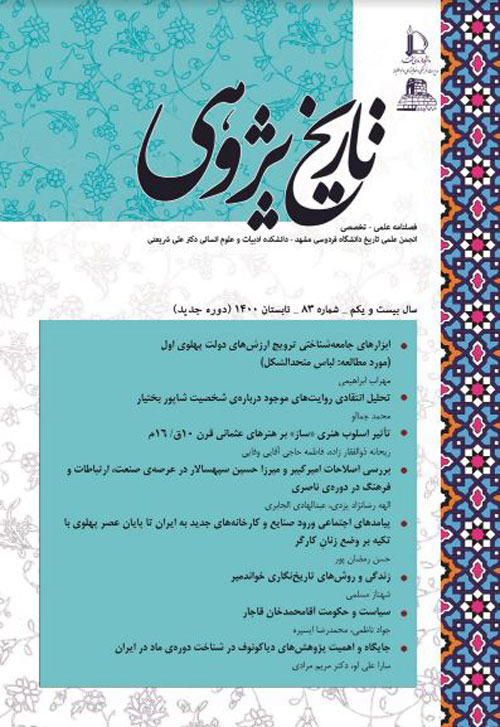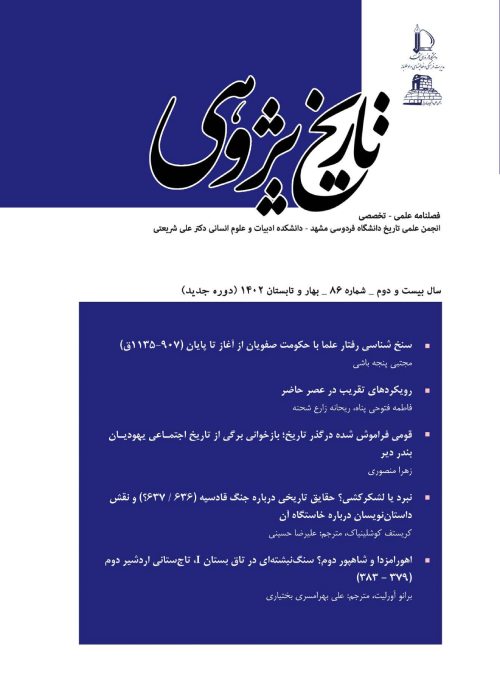فهرست مطالب

نشریه تاریخ پژوهی
پیاپی 83 (تابستان 1400)
- تاریخ انتشار: 1401/01/10
- تعداد عناوین: 8
-
صفحه 157
-
صفحه 177
-
Page 7
The First Pahlavi government was considered illegal like all other governments that are formed as the result of the coup data. Therefore, the government embarked on many initiatives to be considered legal. Taking such norms as nationalism, secularism, and statism can be considered the efforts of the government in this regard. The government used costume as a tool for his political resocialization, as he and his associates took uniform costume as a tool to strengthen their desired values and norms among different and heterogeneous Iranian groups. Taking the uniform costume program started many debates among the elites and other groups of people. The study tried to answer the question: What process and mechanism the First Pahlavi government used for uniforming the costumes as a means for political resocialization? It made the hypothesis that the First Pahlavi government tried to impose a uniform costume to strengthen the sense of unity and connection among the then existing ethnicities and micro cultures and through the process impose his physical existence in society. This hypothesis was examined within the historical sociology framework and using a historical-documentary method.
Keywords: First Pahlavi, Uniform, Political Socialization, Ethnic Unity, Statism -
Page 31
Shapur Bakhtiar is one of the most famous personalities of the National Front and political activists of the late Pahlavi era. Such a comprehensive study on his personality is important as his presence in the events that led to the victory of the Islamic Revolution and the post-revolutionary events is remarkable and as he is known as one of the main personalities of the National Front. According to different existing stories he is different from the remained common images regarding his membership in political circles. It seems that most of the stories and comments about Shapur Bakhtiar have been reproduced in the late Pahlavi era. Each existing narrative has been produced from various perspectives by different narrators. Relying on different narratives about the Shapur Bakhtiar produced by different parties and factional personalities, the study tried to analyze critically the existing narratives and identify the character of Shapur Bakhtiar.
Keywords: Shapur Bakhtiar, National Front, Islamic Revolution, Narratology, Narrative Analysis -
Page 57
Artistic style of “Saz” is one of the elements of Iranian art that the artists of Tabriz School used in Ottoman decorative arts and made some changes in art of Ottoman period. Therefore, the images of angels, dragons, and intertwined sharp leaves (Saz) that originates from the artistic elements of the Tabriz School appeared in Ottoman paintings. Combined with the naturalistic style, the Saz style appeared not only in miniature but also in different kinds of arts such as book designing, illuminating manuscripts, bookbinding, cloth-weaving and decorative tile-working. The Saz style has been extensively used in decorating the tiles of the interior parts of mosques and tombs of Ottoman sultans. This study introduced in detail and described the characteristics of the artistic works that have been decorated using the Saz style in the Ottoman Empire in the 10th AH/16th AD century. Moreover, enumerating the elements of artistic paintings of Saz in monographs that are attributed to the Ottoman Empire, and in the cloth-weaving and tile works of mosques and tombs of Ottoman sultans, the study tried to show to what extent the artistic style of Saz has been used as the main element of Ottoman decorative arts.
Keywords: Iran, Ottoman, Decorative Arts, Artists of Tabriz School, Saz Style, Ottoman Art -
Page 99
After a period of political instability, when Qajar dynasty took power, Iran experienced an apparent stability. Understanding the backwardness of Iran in the Naseri period, Amir Kabir and Mirza Hossein Sepahsalar, two reformist chief ministers, tried to remove the obstacles of development and reform everything pertaining to industry, communications, and culture. Applying a descriptive-analytical method and using documentary sources, newspapers, and primary sources, the study tried to answer the questions: What effects did Amir Kabir and Mirza Hossein Sepahsalar’s reforms have on the industry, communications, and culture in Naseri Iran? What are the similarities and differences between the reforms made by Amir Kabir and Sepahsalar? Amir Kabir and Mirza Hossein Sepahsalar identified the weaknesses of industry, science and culture as the reasons of underdevelopment of Iran. Regarding the industry element, both of them tried to modernize industries by establishing factories and industrial zones. The approach that Amir Kabir took in industry domain was establishing modern European industries financed by Iranian investors and supporting local industries, but Sepahsalar was interested in European countries and granting them the concessions of constructing the industrial zones. Regarding the communications, both of them tried to make post offices with specific regulations. This led to the flourish of businesses. Moreover, their program in establishing new schools with modern fields of study, industry, and newspapers, resulted in a huge group of people educated and trained in various fields.
Keywords: Reforms, Qajar Era, Amir Kabir, Mirza Hossein Sepahsalar, Industry -
Page 129
The entrance of new industries and factories into Iran in the late Qajar and Pahlavi eras had various political, economic, social, and cultural consequences. From amongst its social consequences one can mention the creation of different groups and classes of society that changed people’s lives. Many women were employed by the factories, the effects and consequences of which were inevitable. The study aimed to examine the social effects of the entrance of industry and the establishment of factories on women that worked in them. The main question is: What was the social status of the Iranian women that worked in Qajar and Pahlavi eras? The results showed that such issues as very low wages, long working hours, poor factory hygiene, lack of insurance, employers’ bad behavior and sexual abuse were the most important social consequences of the entrance of the industries for working women. The historiographical study sought to collect data from library sources, analyze the data, and categorize them using a descriptive-analytical method.
Keywords: New Factories, Working Women, Women, Industrialization, Factory Girls, Qajar, Pahlavi -
Page 157
Timurid period witnessed cultural development and attention to historians and chroniclers despite the political weaknesses. Sultan Hussein Bayqara’s period was an appropriate time for the development of historiography. One of the historians of this period is Ghias al-Din Khandmir Heravi, who witnessed the dominance and collapse of Timurids and the beginning of Shibanian and Safavid dynasties. He influenced the establishment of descriptive and religious historiography of Safavid era. The political support of rulers and the advocates of Khandmir in the Timurid and Safavid eras led to the change and evolution of his historiography. He mostly pays attention to the political issues, and mainly discusses those ones that are not in other resources. Cultural issues are discussed in the periphery of the political issues, such that he keeps silent regarding describing events and ignores the opponents of rulers and his advocates. This study used a descriptive-analytical method and new resources and contributions. Criticizing the works of Khandmir, this study tried to understand his status in the historiography of the ninth and tenth centuries. It also tried to see how his political activities and the political and cultural conditions of his time affected the development of his historiography.
Keywords: Khandmir, Political Struggles, Historiography Methods, Timurid Era, Safavid Era, Habib al-Seir -
Page 177
When Safavid dynasty collapsed, Iran faced with riot for more than eight decades and finally Agha Mohammad Khan took over the whole country defeating other rivals and champions. He took over the country, chose Tehran as the capital, and assumed himself the successor of the Safavids to revive the values of Safavid era. Taking a descriptive-analytical method, the study used library resources to identify the politics and governing method of Agha Mohammad Khan in his reign and sought to answer the following questions: What was Agha Mohammad Khan’s perception of politics and governing? What goals he pursued in domestic and foreign policies? As an answer to the questions one can say that seemingly Agha Mohammad Khan pursued his goals in politics and governing through military actions and the majority of his domestic relations and foreign policies were based on eliminating rivals and fighting against other countries.
Keywords: Iran, Qajar, Agha Mohammad Khan, Domestic Policy, Foreign Policy -
Page 197
The book History of Media by Igor Mikhailovich Diakonoff (1958) was translated to Persian by Karim Keshavarz in 1966. The book is Diakonoff’s comprehensive and meticulous researches conducted at that time, as requested the Academy of Sciences of Azerbaijan. The compilation and translation of the book are of importance as before the work there was not any independent books or scientific researches on the Medes period in Persian and the information that historians and archaeologists had about the period had been limited to the writings of Greek historians and some modern Western sources. Such sources were important but as they had not used primary sources, that is, inscriptions, tablets, and archaeological documents, they could not fill the gap of the lack of authentic documents and written sources for those who were interested in researching on this period. Diakonoff’s work is different from other sources in the way that the work provides the readership with a comprehensive information from the sources on this period, carefully examines them, and then turns to geographical and historical issues. These issues made the book one of the main sources of the field such that even after many decades it would be important for those who want to study about Iran and Iranians living in that period. One can see the influence of Diakonoff’s work on the history of the Medes as it has been one of the primary sources of Iranian researches in conducting historical, linguistic, ethnographical, archeological, and interdisciplinary researches. Using a library method, the study aimed to show some part of the influence of the book on the Iranian researcher’s works.
Keywords: Iranian Studies, Igor Diakonoff, Ancient History, The Medes, Historical Studies


